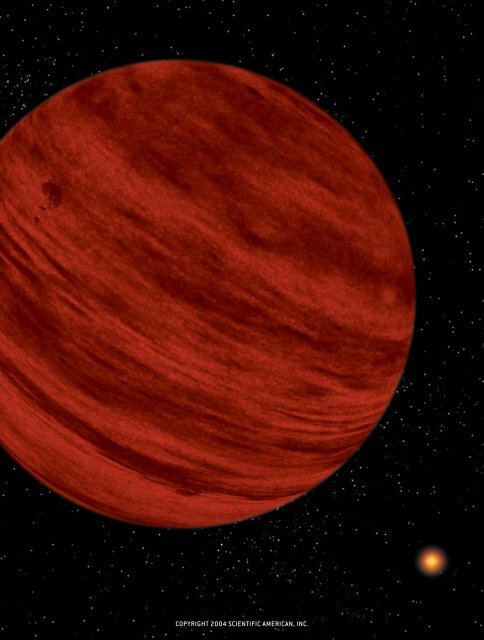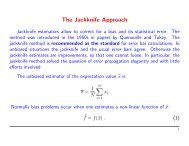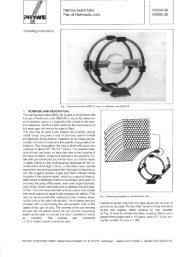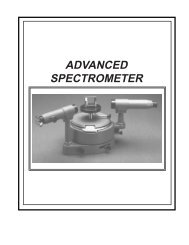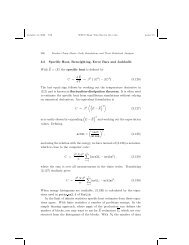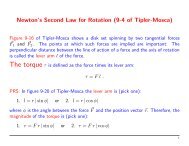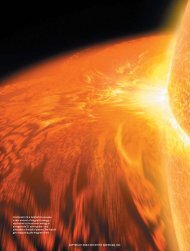The Discovery of Brown Dwarfs - Scientific American Digital
The Discovery of Brown Dwarfs - Scientific American Digital
The Discovery of Brown Dwarfs - Scientific American Digital
- No tags were found...
You also want an ePaper? Increase the reach of your titles
YUMPU automatically turns print PDFs into web optimized ePapers that Google loves.
CREDIT26 SCIENTIFIC AMERICAN THE SECRET LIVES OF STARSCOPYRIGHT 2004 SCIENTIFIC AMERICAN, INC.
THE DISCOVERY OFBROWN DWARFSLess massive than stars but more massive than planets, brown dwarfs werelong assumed to be rare. New sky surveys, however, show that the objectsmay be as common as stars By Gibor BasriPAT RAWLINGS (opposite page); T. NAKAJIMA California Institute <strong>of</strong> Technology AND S. DURRANCE Johns Hopkins University ( left);S. KULKARNI Caltech, D. GOLIMOWSKI Johns Hopkins University AND NASA (right)Abrown dwarf is a failed star. A star shines because<strong>of</strong> the thermonuclear reactions in its core, whichrelease enormous amounts <strong>of</strong> energy by fusing hydrogeninto helium. For the fusion reactions to besustained, though, the temperature in the star’score must reach at least three million kelvins. Andbecause core temperature rises with gravitational pressure, thestar must have a minimum mass: about 75 times the mass <strong>of</strong> theplanet Jupiter, or about 7 percent <strong>of</strong> the mass <strong>of</strong> our sun. Abrown dwarf just misses that mark—it is heavier than a gas-giantplanet but not quite massive enough to be a star.For decades, brown dwarfs were the “missing link” <strong>of</strong> celestialbodies: thought to exist but never observed. In 1963 University<strong>of</strong> Virginia astronomer Shiv Kumar theorized that thesame process <strong>of</strong> gravitational contraction that creates stars fromvast clouds <strong>of</strong> gas and dust would also frequently producesmaller objects. <strong>The</strong>se hypothesized bodies were called blackstars or infrared stars before the name “brown dwarf” was suggestedin 1975 by astrophysicist Jill C. Tarter, now director <strong>of</strong>research at the SETI Institute in Mountain View, Calif. <strong>The</strong>name is a bit misleading; a brown dwarf actually appears red,not brown. But the name “red dwarf” was already taken. (It isused to describe stars with less than half the sun’s mass.)In the mid-1980s astronomers began an intensive search forbrown dwarfs, but their early efforts were unsuccessful. It wasnot until 1995 that they found the first indisputable evidence <strong>of</strong>their existence. That discovery opened the floodgates; sincethen, researchers have detected hundreds <strong>of</strong> the objects. NowBROWN DWARF GLIESE 229B gives <strong>of</strong>f a red glow in this artist’s conception (oppositepage). <strong>The</strong> object is believed to be slightly smaller than Jupiter but about 10 timeshotter and 30 to 40 times more massive. It was discovered in 1995 as a companion tothe red dwarf star Gl 229A (shown in background). Astronomers detected the browndwarf in images from the Palomar Observatory’s 1.5-meter telescope (near right) andfrom the Hubble Space Telescope (far right) that show the object as a faint spot next tothe red dwarf. Gl 229B is actually more than six billion kilometers from its companionstar—farther than Pluto is from our sun.observers and theorists are tackling a host <strong>of</strong> intriguing questions:How many brown dwarfs are there? What is their range<strong>of</strong> masses? Is there a continuum <strong>of</strong> objects all the way down tothe mass <strong>of</strong> Jupiter? And did they all originate in the same way?<strong>The</strong> search for brown dwarfs was long and difficult becausethey are so faint. All astrophysical objects—including stars,planets and brown dwarfs—emit light during their formationbecause <strong>of</strong> the energy released by gravitational contraction. Ina star, the glow caused by contraction is eventually supplantedby the thermonuclear radiation from hydrogen fusion; once itbegins, the star’s size and luminosity stay constant, in most casesfor billions <strong>of</strong> years. A brown dwarf, however, cannot sustainhydrogen fusion, and its light steadily fades as it shrinks[see box on page 31]. <strong>The</strong> light from brown dwarfs is primarilyin the near-infrared part <strong>of</strong> the spectrum. Because browndwarfs are faint from the start and dim with time, some scientistsspeculated that they were an important constituent <strong>of</strong>“dark matter,” the mysterious invisible mass that greatly outweighsthe luminous mass in the universe.Astronomers assumed that a good place to look for very faintobjects would be close to known stars. More than half the starsin our galaxy are in binary pairs—two stars orbiting their commoncenter <strong>of</strong> gravity—and researchers suspected that some starsthat seemed to be alone might actually have a brown dwarf as acompanion. One advantage <strong>of</strong> such a search is that astronomersdo not have to survey large sections <strong>of</strong> sky for brown dwarfs—they can focus their telescopes on small areas near known stars.<strong>The</strong> strategy looked good early on. A likely candidate ap-www.sciam.com Updated from the April 2000 issue 27COPYRIGHT 2004 SCIENTIFIC AMERICAN, INC.
FINDING BROWN DWARFS: SEARCH METHODSGL 229BPPL 15OBSERVING FAINT OBJECTS such as brown dwarfs requires specialstrategies. One approach is to focus telescopes on areas near known starsand to look for companions; astronomers used this method to find Gl 229B(above left). Another strategy is to concentrate on young star clusters,because brown dwarfs are brightest when they are young. Scientistssearched the 120-million-year-old Pleiades cluster (above center) to findthe brown dwarf PPl 15 (center inset) as well as many others. Last,KELU-1astronomers can find “field” brown dwarfs by imaging large sections <strong>of</strong> skywith instruments that are sensitive to faint, red sources. <strong>The</strong> discovery <strong>of</strong>the first field brown dwarf, Kelu-1 (above right), was announced in 1997.peared in 1988, when Eric Becklin andBenjamin Zuckerman <strong>of</strong> the University <strong>of</strong>California at Los Angeles reported thediscovery <strong>of</strong> GD 165B, a faint red companionto a white dwarf. White dwarfsare unrelated to brown dwarfs: they arethe corpses <strong>of</strong> moderately massive starsand are smaller, hotter and much heavierthan brown dwarfs. GD 165B may indeedbe a brown dwarf, but astronomershave been unable to say for certain becausethe object’s inferred mass is close tothe 75-Jupiter-mass boundary betweenlow-mass stars and brown dwarfs.Another advantage <strong>of</strong> looking forbrown dwarfs as companions to stars isthe brown dwarf itself doesn’t necessarilyhave to be observed. Researchers candetect them with the same method usedto find extrasolar planets: by observingtheir periodic effects on the motions <strong>of</strong>the stars they are circling. Astronomersdetermine the variations in the stars’ velocitiesby measuring the Doppler shiftsin the stars’ spectral lines. It is actuallyeasier to detect brown dwarfs than planetsby this technique because <strong>of</strong> theirgreater mass.Nevertheless, famed planet hunterGe<strong>of</strong>frey W. Marcy <strong>of</strong> San FranciscoState University and the University <strong>of</strong>California at Berkeley found no browndwarfs in a survey <strong>of</strong> 70 low-mass starsconducted in the late 1980s. In the mid-1990s Marcy discovered half a dozen extrasolargas-giant planets in a survey <strong>of</strong>107 stars similar to our sun but still sawno clear-cut evidence <strong>of</strong> brown dwarfs.<strong>The</strong> failure <strong>of</strong> these efforts gave rise to theterm “brown dwarf desert” because theobjects appeared to be much less commonthan giant planets or stars.Only one <strong>of</strong> the early Doppler-shiftsearches detected a brown dwarf candidate.In a 1988 survey <strong>of</strong> 1,000 stars,David W. Latham <strong>of</strong> the Harvard-SmithsonianCenter for Astrophysics found astellar companion at least 11 times asmassive as Jupiter. <strong>The</strong> Doppler-shiftmethod, though, provides only a lowerlimit on a companion’s mass, so Latham’sobject could be a very low mass starinstead <strong>of</strong> a brown dwarf. This issue willremain unresolved until scientists can determinestellar positions more precisely.Meanwhile other astronomers pursueda different strategy that took advantage<strong>of</strong> the fact that brown dwarfs arebrightest when they are young. <strong>The</strong> bestplace to look for young objects is in starclusters. <strong>The</strong> stars in a cluster all form atthe same time but have very different lifetimes.<strong>The</strong> most massive stars shine foronly a few million years before runningout <strong>of</strong> hydrogen fuel and leaving themain-sequence phase <strong>of</strong> their lifetimes,whereas low-mass stars can keep shiningfor billions, even trillions, <strong>of</strong> years. <strong>The</strong>standard method for estimating the age <strong>of</strong>a cluster amounts to finding its most massivemain-sequence star. <strong>The</strong> age <strong>of</strong> thecluster is roughly the lifetime <strong>of</strong> that star.Once researchers locate a young clusterand determine its age, they need onlylook for the faintest, reddest (and thereforecoolest) objects in the cluster to identifythe brown dwarf candidates. <strong>The</strong>oryprovides the expected surface temperatureand luminosity <strong>of</strong> objects <strong>of</strong> variousmasses for a given age, so by measuringthese properties astronomers can estimateeach candidate’s mass. Severalteams began the search, imaging the areas<strong>of</strong> sky containing young clusters andpicking out faint red objects.<strong>The</strong> research teams made a series <strong>of</strong>announcements <strong>of</strong> brown dwarf candidatesin young clusters, including thestar-forming region in the Taurus constellationand the bright cluster called thePleiades (better known as the Seven Sisters).Unfortunately, closer scrutinyshowed that none <strong>of</strong> the candidates wasreally a brown dwarf. Some turned outto be red giant stars located thousands <strong>of</strong>light-years behind the cluster; becausethese background stars are so distant,they appear faint even though they arequite luminous. Others were low-massstars behind or in front <strong>of</strong> the cluster.Some <strong>of</strong> the “discoveries” made it intothe press, but the later retractions wereT. NAKAJIMA Caltech AND S. DURRANCE Johns Hopkins University ( left); SPACE TELESCOPE SCIENCE INSTITUTE (top, center);JOHN STAUFFER Harvard-Smithsonian Center for Astrophysics ( bottom, center); EUROPEAN SOUTHERN OBSERVATORY (right)28 SCIENTIFIC AMERICAN THE SECRET LIVES OF STARSCOPYRIGHT 2004 SCIENTIFIC AMERICAN, INC.
not given much play. This led to furtherskepticism among astronomers towardall brown dwarf announcements and reinforcedthe widespread view that theobjects were rare.Looking for LithiumIN 1992 RAFAEL REBOLO, EduardoL. Martín and Antonio Magazzú <strong>of</strong> theAstrophysics Institute in Spain’s CanaryIslands proposed a clever new method tohelp distinguish low-mass stars frombrown dwarfs. Called the lithium test, itexploits the fact that below a mass <strong>of</strong>about 60 Jupiter masses, a brown dwarfnever achieves the conditions necessaryto sustain lithium fusion in its core. Thisnuclear reaction occurs at a slightly lowertemperature than hydrogen fusiondoes; as a result, stars quickly consumewhatever lithium they originally had.Even the lowest-mass star burns all itslithium in about 100 million years,whereas all but the most massive browndwarfs retain their lithium forever. Thus,the continued presence <strong>of</strong> lithium is asign that the object has a substellar mass.<strong>The</strong> spectral lines produced by lithiumare fairly strong in cool red objects.<strong>The</strong> Canary Islands group looked forthese lines in all the coolest objects in thesky that are also bright enough to providea spectrum <strong>of</strong> the needed quality.None showed evidence <strong>of</strong> lithium. In1993 another team—consisting <strong>of</strong> myself,Marcy and James R. Graham <strong>of</strong>Berkeley—began to apply the lithium testto fainter objects using the newly built10-meter Keck telescope on Mauna Keain Hawaii. We, too, met with failure atfirst, but our luck changed when we focusedon the Pleiades cluster.A group <strong>of</strong> British astronomers hadjust conducted one <strong>of</strong> the broadest, deepestsurveys <strong>of</strong> the cluster. <strong>The</strong>y found severalobjects that by all rights should havehad substellar masses. <strong>The</strong>y showed thatthese objects shared the proper motion <strong>of</strong>the cluster across the sky and thus had tobe members <strong>of</strong> the cluster rather thanbackground stars. We went right to thefaintest one, an object called HHJ 3, expectingto find lithium. It was not present.But Harvard-Smithsonian Center astronomerJohn Stauffer supplied us withanother target. He, too, had been surveyingthe Pleiades for low-mass objects andhad detected an even fainter candidate,dubbed PPl 15 (the 15th good candidatein the Palomar Pleiades survey). At last,we were successful: for the first time wedetected lithium in an object for which itspresence implied a substellar mass. We reportedthe discovery at the June 1995meeting <strong>of</strong> the <strong>American</strong> AstronomicalSociety. Our results indicated that thecluster was about 120 million years old,giving PPl 15 an inferred mass at the upperend <strong>of</strong> the brown dwarf range.In one <strong>of</strong> the interesting convergencesthat seem to occur regularly in science,other research teams also reported strongevidence <strong>of</strong> brown dwarfs in 1995. <strong>The</strong>Canary Islands group had also been conductinga deep survey <strong>of</strong> the Pleiadescluster and had detected two objects evenfainter than PPl 15: Teide 1 and Calar 3,both named after Spanish observatories.Each had an inferred mass just below 60Jupiter-masses. By the end <strong>of</strong> the year Ihad teamed up with the Canary Islandsgroup, and we confirmed the expectedpresence <strong>of</strong> lithium in both objects. <strong>The</strong>astronomical community retained someskepticism about these objects for thefirst few months—after all, they stilllooked like stars—until further discoveriesmade it clear that now the browndwarfs were for real.At the same time, a very differentCONFIRMING THE DISCOVERIES: THE LITHIUM TESTBRYAN CHRISTIE (left); LAURIE GRACE (right)Lithium 7ProtonLITHIUM DESTRUCTIONImpactHelium 4ANALYZING THE SPECTRA <strong>of</strong> faint objects can reveal whether they arestars or brown dwarfs. All stars destroy the lithium in their cores; inthis reaction, a proton collides with the isotope lithium 7, which thensplits into two helium atoms (left). In contrast, all but the mostmassive brown dwarfs cannot achieve the core temperature neededRelative Intensity3.0Low-mass star HHJ 32.5<strong>Brown</strong> dwarf PPl 152.01.51.00.5Lithiumline0.0667 668 669 670 671 672 673Wavelength (nanometers)for lithium destruction, so they retain the element forever. <strong>The</strong>spectrum <strong>of</strong> HHJ 3 (right, yellow line), a low-mass star in the Pleiadescluster, shows no sign <strong>of</strong> lithium. <strong>The</strong> spectrum <strong>of</strong> brown dwarf PPl 15(red line), however, has a strong absorption line indicating thepresence <strong>of</strong> the light metallic element.www.sciam.com SCIENTIFIC AMERICAN 29COPYRIGHT 2004 SCIENTIFIC AMERICAN, INC.
Fraction <strong>of</strong> Sun’s Luminosity110 –210 –410 –6PPl 15Teide 110 –8 10 6 10 7 10 8LUMINOSITY HISTORY <strong>of</strong> low-mass stars (yellow lines), brown dwarfs (red lines) and planets (black line)shows that only stars are massive enough to achieve a stable luminosity. <strong>The</strong> light from brown dwarfs andplanets fades as they age. Data from brown dwarfs (black crosses) indicate how old and heavy they are.search bore spectacular fruit. A groupfrom the California Institute <strong>of</strong> Technologyand Johns Hopkins University hadbeen looking for brown dwarf companions<strong>of</strong> nearby low-mass stars. <strong>The</strong> astronomershad equipped the Palomar 1.5-meter telescope with an instrument thatblocked most <strong>of</strong> the light <strong>of</strong> the primarystar, allowing a faint nearby companionto be more easily seen. In 1993 they observedseveral brown dwarf candidates.<strong>The</strong>y took second images a year later. Becausethe targets are relatively close to oursolar system, their movements throughthe galaxy are perceptible against thebackground stars. If a candidate is truly acompanion, it will share this motion. One<strong>of</strong> the companions confirmed was 1,000times fainter than its primary, the lowmassstar Gliese 229A. Because the primarywas already known to be faint, thecompanion’s luminosity had to be wellbelow that <strong>of</strong> the faintest possible star.<strong>The</strong> group kept quiet until it obtained aninfrared spectrum <strong>of</strong> the object.At a meeting <strong>of</strong> the CambridgeWorkshop on Cool Stars, Stellar Systemsand the Sun in October 1995, the Caltech/JohnsHopkins group announcedAge <strong>of</strong> Object (years)the discovery <strong>of</strong> Gl 229B, the browndwarf companion to Gl 229A. It wasclearly substellar by virtue <strong>of</strong> its faintness,and the clincher was the detection<strong>of</strong> methane in its spectrum. Methane iscommon in the atmospheres <strong>of</strong> the giantplanets, but all stars are too hot to allowit to form. Its strong presence in Gl 229Bguaranteed that this object could not bea star. At the same meeting the CanaryIslands group reported the observation<strong>of</strong> several new brown dwarf candidatesin the Pleiades cluster, suggesting thatthese objects might be fairly numerous.In addition, a group led by Michel Mayor<strong>of</strong> the Geneva Observatory in Switzerlandannounced the discovery <strong>of</strong> thefirst extrasolar planet, a gas giant circlingthe star 51 Pegasi. In one morning, thefrustrating search for substellar objectscame to a dramatic conclusion.Most astronomers view Gl 229B asTHE AUTHORKelu-1Gl 229BMass <strong>of</strong> Object(Jupiter masses)2001259080705030151010 9 10 10the first indisputable brown dwarf discoveredbecause it is a million timesfainter than the sun and has a surfacetemperature under 1,000 kelvins—far belowthe minimum temperature that eventhe faintest star would generate (around1,800 kelvins). It has reached this statebecause it is a few billion years old. It isprobably 30 to 40 times more massivethan Jupiter. In contrast, PPl 15, Teide 1and Calar 3 in the Pleiades are more massive(from 50 to 70 Jupiter masses) andalso much hotter (with surface temperaturesbetween 2,600 and 2,800 kelvins),primarily because they are much younger.Once the methods for detectingbrown dwarfs had been proved, the discoveriescame at an increasing pace. Severalgroups returned to the Pleiades. <strong>The</strong>Canary Islands group, now includingMaria Rosa Zapatero Osorio <strong>of</strong> the Laboratoryfor Space Astrophysics and <strong>The</strong>oreticalPhysics, near Madrid, discovereda Pleiades brown dwarf only 35 timesmore massive than Jupiter—the lightestbrown dwarf found in the cluster. Moreimportant, the Canary Islands group conductedthe first useful assessment <strong>of</strong> thenumber <strong>of</strong> brown dwarfs in the Pleiadesby counting the most likely candidates ina small surveyed area and then extrapolatingthe tally for the entire cluster. <strong>The</strong>results indicated comparable numbers <strong>of</strong>stars and brown dwarfs in the Pleiades. Iftrue in general, this would mean that ourgalaxy alone contains about 100 billionbrown dwarfs. But it also means thatbrown dwarfs are not the dominant constituent<strong>of</strong> the universe’s mass, becausethey are much lighter than stars. <strong>The</strong>hope that they would provide an answerto the dark matter mystery has faded.Other researchers focused on howthe brown dwarfs are distributed bymass. What is the lowest mass a browndwarf can attain? Is there a continuum <strong>of</strong>objects down to the planetary range—below13 Jupiter masses—or is there a gapGIBOR BASRI is a pr<strong>of</strong>essor in the astronomy department at the University <strong>of</strong> California,Berkeley. He received his Ph.D. in astrophysics from the University <strong>of</strong> Colorado at Boulderin 1979. Basri has studied solar-type stars, low-mass stars and star formation using a variety<strong>of</strong> telescopes, including the Lick and Keck observatories, as well as spaceborne instruments,including the Hubble Space Telescope. He is keen on promoting an interest inscience among groups currently underrepresented in the field.LAURIE GRACE30 SCIENTIFIC AMERICAN THE SECRET LIVES OF STARSCOPYRIGHT 2004 SCIENTIFIC AMERICAN, INC.
<strong>The</strong> Life Cycle<strong>of</strong> <strong>Brown</strong> <strong>Dwarfs</strong><strong>The</strong> early lives <strong>of</strong> brown dwarfs and stars follow thesame pattern. Both are believed to originate from thegravitational collapse <strong>of</strong> interstellar clouds <strong>of</strong> gas anddust. <strong>The</strong>se clouds are composed primarily <strong>of</strong>hydrogen and helium, but they also initially containsmall amounts <strong>of</strong> deuterium and lithium that areremnants <strong>of</strong> the nuclear reactions that took placea few minutes after the big bang.As young stars and brown dwarfs contract, theircores grow hotter and denser, and the deuteriumnuclei fuse into helium 3 nuclei. (Deuterium fusioncan occur in brown dwarfs because it requires a lowertemperature—and hence a lower mass—thanhydrogen fusion.) <strong>The</strong> outpouring <strong>of</strong> energy fromthese reactions temporarily halts the gravitationalcontraction and causes the objects to brighten. Butafter a few million years the deuterium runs out, andthe contraction resumes. Lithium fusion occurs next in starsand in brown dwarfs more than 60 times as massive as Jupiter.During the contraction <strong>of</strong> a brown dwarf, thermal pressurerises in its core and opposes the gravitational forces. All theelectrons are freed from their nuclei by the heat. Because notwo electrons can occupy the same quantum state, when thecore is very dense the low-energy states are filled, and manyelectrons are forced to occupy very high energy states. Thisgenerates a form <strong>of</strong> pressure that is insensitive to temperature.Objects supported in this manner are called degenerate. Oneconsequence <strong>of</strong> this process is that all brown dwarfs are roughlythe size <strong>of</strong> Jupiter—the heavier brown dwarfs are simply denserthan the lighter ones.In stars the cores do not become degenerate. Instead hydrogenfusion provides the pressure that supports the star against its owngravity. Once fusion begins in earnest, the star stops contractingand achieves a steady size, luminosity and temperature. In highmassbrown dwarfs, hydrogen fusion begins but then sputters out.As degeneracy pressure slows the collapse <strong>of</strong> brown dwarfs, theirluminosity from gravitational contraction declines. Although verylow mass stars can shine for trillions <strong>of</strong> years, brown dwarfs fade1 MILLION YEARS<strong>Brown</strong> Dwarf and Accretion DiskRadius <strong>of</strong> disk: 1 billion–5 billion kmRadius <strong>of</strong> brown dwarf: 350,000 kmTemperature: 2,900 K10 MILLION YEARS<strong>Brown</strong> Dwarf and PlanetRadius <strong>of</strong> planet's orbit:2 million–500 million kmRadius <strong>of</strong> brown dwarf: 300,000 kmTemperature: 2,900 K100 MILLION YEARSGravitational ContractionRadius <strong>of</strong> brown dwarf:100,000 kmTemperature: 2,500 K1 BILLION YEARSRadiative CoolingRadius <strong>of</strong> brown dwarf:65,000 kmTemperature: 1,200 K100,000 YEARSInterstellar Molecular CloudRadius: 100 billion kilometersTemperature: 10 kelvins10 BILLION YEARSFading to OblivionRadius <strong>of</strong> brown dwarf:60,000 kmTemperature: 550 KAccretion disk and planetaryorbit not drawn to scale.BROWN DWARF IS BORN from the contraction <strong>of</strong> a vast cloud <strong>of</strong> gas and dust.After a million years the object is a glowing ball <strong>of</strong> gas, possibly surroundedby an accretion disk from which an orbiting planet could later arise. (So farno planets have been detected around brown dwarfs; their existence andpossible orbits are strictly hypothetical.) Over time the brown dwarf shrinksand cools. <strong>The</strong> radii and surface temperatures shown here are for an object<strong>of</strong> 40 Jupiter masses.steadily toward oblivion. This makes them increasingly difficult t<strong>of</strong>ind as they age. In the very distant future, when all stars haveburned out, brown dwarfs will be the primary repository <strong>of</strong>hydrogen in the universe.—G.B.BRYAN CHRISTIEbetween the lightest brown dwarf andthe heaviest planet because they areformed by different mechanisms?<strong>The</strong> best place to answer these questionsis in newly forming star clusters,where even very low mass brown dwarfsare still bright enough to see. Surveys <strong>of</strong>various nearby star-forming regions haveturned up a number <strong>of</strong> objects that seemcool and dim enough to lie near, or evenbelow, the fusion limit, as predicted bymodels. <strong>The</strong> models are not very reliablefor such objects, however, so there hasbeen some skepticism, and some objectshave turned out to not actually be in thestar-forming regions. Recently, though,work by me, Subhanjoy Mohanty <strong>of</strong> theHarvard-Smithsonian Center and ourcollaborators has taken a more directtack. We do not rely on evolutionarymodels but deduce the surface gravity <strong>of</strong>confirmed members by studying theirspectral lines (which broaden as gravityand pressure increase). We confirm verylow masses in some cases. Thus, it appearsthat brown dwarfs are produced inall possible masses between planets andstars [see box on next page].Continuing searches for browndwarfs around solar-type stars have confirmedthe initial impression that they arefairly rare in this situation. <strong>Brown</strong> dwarfsappear to be more common, though, ascompanions to lower-mass stars. In 1998Rebolo and his co-workers discoveredone orbiting the young star G196-3. Despiteits youth, this brown dwarf is alreadyquite cool, which means it must belight, perhaps only 20 Jupiter masses.<strong>The</strong> first binary system involving twobrown dwarfs was identified by Martínand me. We determined that the Pleiadeswww.sciam.com SCIENTIFIC AMERICAN 31COPYRIGHT 2004 SCIENTIFIC AMERICAN, INC.
Planets versus <strong>Brown</strong> <strong>Dwarfs</strong>Is there a fundamental difference between thelargest planets and the smallest brown dwarfs? <strong>The</strong>classical view is that planets form in a different way thanbrown dwarfs or stars do. Gas-giant planets are thought tobuild up from planetesimals—small rocky or icy bodies—amid adisk <strong>of</strong> gas and dust surrounding a star. Within a few millionyears these solid cores attract huge envelopes <strong>of</strong> gas. Thismodel is based on our own solar system and predicts that allplanets should be found in circular orbits around stars and thatgas-giant planets should travel in relatively distant orbits.<strong>The</strong>se expectations have been shattered by the discovery<strong>of</strong> the first extrasolar giant planets. Most <strong>of</strong> these bodies havebeen found in close orbits, and most travel in eccentric ovalsrather than in circles. Some theorists have even predictedthe existence <strong>of</strong> lone planets, thrown out <strong>of</strong> theirstellar systems by orbital interactions withsibling planets. This makes it very hard for observers todistinguish planets from brown dwarfs on the basis <strong>of</strong> how orwhere they formed or what their current location and motion is.We can find brown dwarfs by themselves or as orbitalcompanions to stars or even other brown dwarfs. <strong>The</strong> samemay be true for giant planets.An alternative approach is gaining adherents: todistinguish between planets and brown dwarfs based onwhether the object has ever managed to produce any nuclearfusion reactions. In this view, the dividing line is set at about13 Jupiter masses. Above that mass, deuterium fusion occursin the object. <strong>The</strong> fact that brown dwarfs seem to be lesscommon than planets—at least as companions to moremassive stars—suggests that the two types <strong>of</strong> objects mayform by different mechanisms. A mass-based distinction,however, is much easier to observe.—G.B.Molecular hydrogenand heliumMetallichydrogenFullyconvectiveJupiterCONTINUUM OF OBJECTS from planets to stars (below) shows that older brown dwarfs,such as Gliese 229B, are fairly similar to gas-giant planets in size and surfacetemperature. Younger brown dwarfs, such as Teide 1, more closely resemble low-massstars, such as Gliese 229A. <strong>Brown</strong> dwarfs and low-mass stars are fully convective,meaning that they mix their contents (left). <strong>The</strong>rmonuclear reactions in the stars’ coresdestroy all their lithium, so its presence is a sign that the object may be a brown dwarf.Lithium<strong>Brown</strong>dwarf<strong>The</strong>rmonuclearreactionsNo lithiumFullyconvectiveReddwarfstarNameType <strong>of</strong> objectMass (Jupiter masses)Radius (kilometers)Temperature (kelvins)Age (years)Hydrogen fusionDeuterium fusionJupiterGas-giant planet171,5001004.5 billionNoNoGliese 229B<strong>Brown</strong> dwarf30–4065,0001,0002–4 billionNoYesTeide 1<strong>Brown</strong> dwarf55150,0002,600120 millionNoYesGliese 229ARed dwarf star300250,0003,4002–4 billionYesYesSunYellow dwarf star1,000696,0005,8004.5 billionYesYes32 SCIENTIFIC AMERICAN THE SECRET LIVES OF STARSCOPYRIGHT 2004 SCIENTIFIC AMERICAN, INC.
We now have an idea <strong>of</strong> how brown dwarfs lookAS THEIR ATMOSPHERES COOL TOalmost planetary temperatures.BRYAN CHRISTIEbrown dwarf PPl 15 is really a close pair<strong>of</strong> brown dwarfs, with an orbital period<strong>of</strong> six days. Together with Germanastronomer Wolfgang Brandner, we alsoresolved the first nearby binary pair <strong>of</strong>very cool objects with the Hubble SpaceTelescope. Such systems should providethe first real dynamical masses <strong>of</strong> browndwarfs within a few years.Several subsequent studies haveshown that the fraction <strong>of</strong> very cool objectsthat turn out to be double in spacetelescope images is about 20 percent (thefraction <strong>of</strong> stellar binaries at any separationis about 50 percent). <strong>The</strong>se observationssuggest that the brown dwarf desertis only a lack <strong>of</strong> brown dwarfs as companionsto more massive stars. Whenlooking near low-mass objects (eitherstars or brown dwarfs), the likelihood <strong>of</strong>finding a brown dwarf companion ismuch greater. This variance probably resultsfrom the process that gives birth tobinary systems, which is still poorly understood.Apparently this process is lesslikely to produce a system in which theprimary object is more than about 10times the mass <strong>of</strong> the secondary. Remarkably,the brown dwarfs are never foundwith separations more than about the size<strong>of</strong> our solar system, even though that isonly the median separation for stars.<strong>Brown</strong> <strong>Dwarfs</strong> EverywhereASTRONOMERS FOUND still morebrown dwarfs using another search technique:looking for them at random locationsin the sky. <strong>The</strong>se “field” browndwarfs are easily lost among the myriadstars <strong>of</strong> our galaxy. To locate such objectsefficiently, one must image large sections<strong>of</strong> sky with great sensitivity to faint redsources. <strong>The</strong> first field brown dwarf wasannounced by Maria Teresa Ruiz <strong>of</strong> theUniversity <strong>of</strong> Chile in 1997. She dubbedit “Kelu-1” from a South <strong>American</strong> Indianword for “red” and noted that it showslithium. At about the same time, theDeep Near-Infrared Survey (DENIS)—a European project that scans the southernhemisphere <strong>of</strong> the sky—found threesimilar objects. Researchers quickly confirmedthat one contains lithium.<strong>The</strong> Two Micron All Sky Survey(2MASS), managed by the University <strong>of</strong>Massachusetts at Amherst, has detectedeven more field brown dwarfs. <strong>The</strong> team,including J. Davy Kirkpatrick <strong>of</strong> NASA’sIPAC center in Pasadena, Calif., hasfound hundreds <strong>of</strong> new extremely coolobjects and confirmed lithium in over 50.Most <strong>of</strong> these objects have surface temperaturesgreater than 1,500 kelvins andso must be younger than about a billionyears. <strong>The</strong>y are relatively bright and easierto observe than older objects.<strong>The</strong> hunt for older field brown dwarfswas frustrated until the summer <strong>of</strong> 1999,when the Sloan <strong>Digital</strong> Sky Survey (whichuses optical detectors) turned up twobrown dwarfs containing methane intheir atmospheres. <strong>The</strong> presence <strong>of</strong> methaneindicates a surface temperature below1,300 kelvins and hence an age greaterthan one billion to two billion years. Atthe same time, the 2MASS group reportedthe observation <strong>of</strong> four similar objects.Most <strong>of</strong> the brown dwarfs in our galaxyshould be methane-bearing, because themajority formed long ago and shouldhave now cooled to that state. Thus, thesediscoveries are just the tip <strong>of</strong> the iceberg.Adam Burgasser <strong>of</strong> Caltech and othershave now been able to collect a largeenough sample <strong>of</strong> older brown dwarfs togive us a preliminary idea <strong>of</strong> how theylook as their atmospheres cool to nearplanetarytemperatures.Further study <strong>of</strong> very cool objects hasyielded clues to the composition and evolution<strong>of</strong> brown dwarf atmospheres. <strong>The</strong>irMORE TO EXPLOREoptical spectra lack the molecules <strong>of</strong> titaniumoxide and vanadium oxide thatdominate the spectra <strong>of</strong> low-mass stars.<strong>The</strong>se molecules do not appear, becausetheir constituent heavy elements condenseinto hard-to-melt dust grains. <strong>The</strong> primaryoptical spectral lines are from molecules<strong>of</strong> hydrides, instead <strong>of</strong> oxides, and fromneutral alkali metals. <strong>The</strong> dust grains forminto clouds, whose height appears to dropas the objects cool. <strong>The</strong>re is some evidencethe clouds may not always cover thewhole object, so one might be able to study“weather” on brown dwarfs. <strong>The</strong> dustclouds sink below the visible surface in themethane objects, whose optical spectrathen are dominated by sodium and potassium.<strong>The</strong>se spectral lines are broadenedeven more than in high-pressure streetlamps, making the color <strong>of</strong> the objects magenta(not brown!).<strong>The</strong> initial discovery phase for browndwarfs is now almost over. Astronomershave good methods for detecting themand many targets for detailed study. Indeed,the 2MASS and DENIS teamshave found that the number <strong>of</strong> fieldbrown dwarfs in the surveyed areas issimilar to the number <strong>of</strong> low-mass starsin those areas. <strong>Brown</strong> dwarfs seem to benearly as common as stars.Over the next few years, scientists willget a better handle on the basic factsabout brown dwarfs: their numbers,masses and distribution in our galaxy.Researchers will also try to determinehow they form as binary or solo objectsand what processes take place as theiratmospheres cool. It is remarkable thatthese nearby and common objects, asabundant as stars, have only now begunto reveal their secrets.<strong>Brown</strong> <strong>Dwarfs</strong>: A Possible Missing Link between Stars and Planets. S. R. Kulkarni in Science,Vol. 276, pages 1350–1354; May 30, 1997.<strong>Brown</strong> <strong>Dwarfs</strong> and Extrasolar Planets. Edited by R. Rebolo, E. L. Martín and M. R. Zapatero Osorio.Astronomical Society <strong>of</strong> the Pacific Conference Series, Vol. 134, 1998.More on brown dwarfs is available at astron.berkeley.edu/~basri/bdwarfs/www.sciam.com SCIENTIFIC AMERICAN 33COPYRIGHT 2004 SCIENTIFIC AMERICAN, INC.


